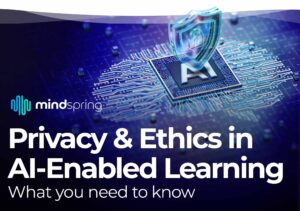We’re excited to host this guest blog post by Dr. Bill Ryan. Dr. Ryan is an experienced instructional designer, having spent nearly 30 years mastering learning and development. Dr. Ryan has worked heavily in the insurance industry and has some great thoughts about learning strategy.
Creating effective learning within an organization is a difficult task. You’ve got to consider the content, design, communication method, project management and much more. But before you can dive too deeply into the creation of a learning program, you’ve got to have a solid learning strategy. Without one, your project is doomed to fail.
Here are four necessary components required for a robust learning strategy:
1. Provide necessary skills. Basic training brings the fundamentals of the role to the employee and involves the technical skills needed and should include the professional, soft, competencies the organization wants all employees to have in terms of communication, culture, and collaboration skills. If you wonder why these soft skills are a component of a learning strategy it is because they impact the bottom line. Recently, an organization was faced with a turnover rate of 60% and looked for a new way to retain its employees. While their recruiters were finding employees with the degrees and experience the leadership surmised that something was missing. A system was implemented to define and measure who had the competencies needed for specific roles. “We could train people on technical skills but it’s really hard to teach things like compassion and understanding.” The result was a drop in turnover to under 20%.
Basic training is also an opportunity to build strong relationships with your operational business partners by strategically planning mentoring and coaching help if a new employee is having a difficult time with a particular task, to provide clarification and instruction from a seasoned “expert”. A final part of this strategic channel is obtaining regular feedback from the business to share with the new employee so they can continue to improve and to review and revise the curriculum in identified areas of opportunity.
2. Nurture Talent! The second part of your learning strategy is targeting existing employees and offering professional development opportunities. While it has been said that the only thing worse than training employees and losing them is not training them and keeping them it has been proven that retaining employees is a business metric that cuts costs and increases productivity. A component of this phase of the learning strategy is to partner with Human Resources and develop career pathways with specific learning and development milestones. A career path gives the employee a sense of direction, a way to assess career progress, and career goals and milestones. These development opportunities may include job shadowing, special projects, specific skills training, tuition reimbursement, and leadership development programs. Career pathing with targeted learning opportunities highlights to employees their connection to the business and increases engagement which is a key learning as well as business strategy. A part of your strategy is to demonstrate to leadership how learning can help grow the organization and reducing attrition is a powerful metric. Identifying employees with growing potential and increased experience, education, and skills that can be applied in new business areas creates a visionary mindset that can leverage learning to deliver an upskilled workforce.
3. Smart partnerships. The third part of your learning strategy is developing an active partnership with the business teams to improve performance. This component is more than the basic training where the content is what people need to perform the job. Here you focus on what people need to do to perform the job at a consistent and high level. This part of your learning strategy works to evaluate what the business partner really needs and not necessarily what they think they need. Remember Joe? Utilizing this component of your learning strategy would allow the two of you to review the quality data to see if the problem was from new hires, new procedures, or changes to the process. Instead of hours spent in a classroom “training” the solution may be a job aid or a quick update on a changed process allowing you to positively impact performance without disrupting operations.
4. Metrics! The fourth and final part of your learning strategy is based on the data from your business partners. Most training groups measure their success by how many people were trained or took their online modules and what scores they received. While nice to know the true measure of learning’s impact is the results that the business teams measure. Identify the rubrics they use such as quality scores, material waste, call response/resolution volume, customer retention rates and others. A key group to partner with is your internal audit and/or quality team. They measure business results and can provide you a detailed analysis of what is going right and where employees are having problems. Use this information to revise content in new hire training and quickly develop content to bring to the business teams to mitigate their performance concerns and identifying your team as a key strategic partner.
The goal of a learning strategy is to ensure that all employees are able to perform their jobs from the beginning of their employment and create a talent pool that can grow the organization. A learning strategy creates learners who grow into leaders.









